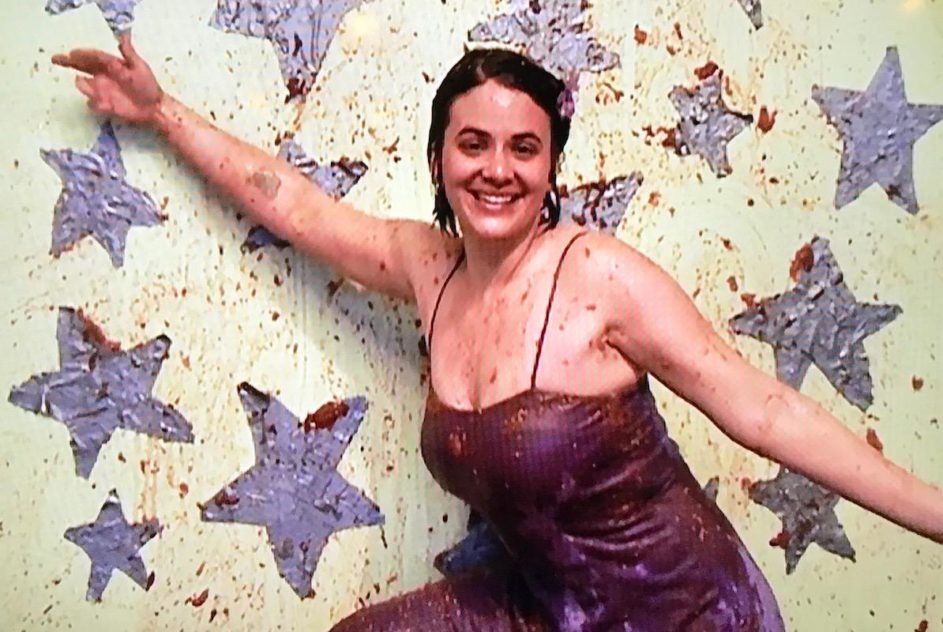Ewing Gallery on the campus of the University of Tennessee is currently showing the provocative work of artist Kate Gilmore, whose pieces question ideas of femininity, gender and roles in society.
Most of the pieces in the exhibition are videos of Gilmore herself, or women paid to carry out the task in each video, all of which involve deconstruction in one form or another.
One of the works, with the unprintable title of “Bend M—–f—–,” the only actual physical piece in the show, breaks down the barrier between artist and audience. Anyone who chooses to don safety glasses and earplugs can beat up a slick, red-painted steel cube with a sledgehammer. With it, the participants replace the women in the videos as the labor force. The idea is that we are all in life together. Every blow leaves a profound mark. The stress and the damage done to the cubes are like wounds and scars that humanize the sleek cubes and express life’s turbulence.

Photo of the beginning of “Sudden as a Massacre,” taken from Gilmore’s exhibition catalogue
Performance art has been around since the 1970s. But Gilmore’s work is something different. Traditional performance art is a kind of mix between painting, sculpture, poetry and theater, in which the performers follow a script, or improvise, to achieve an objective or express a set of ideas.
Gilmore’s work, on the other hand, is more of an extension of abstract expressionism and conceptual art that poses questions about non-visual matters affecting society. Her subject is the place and role of gender and how women are affected and limited by social constraints, especially regarding what is appropriate work for women. She is increasingly gaining international attention since appearing in the 2010 Whitney Biennial exhibition in New York.
In Gilmore’s 2005 work “With Open Arms,” a 5-minute, 40-second video, she raises questions about stardom, beauty and celebrity. The setup of the piece is silver, aluminum-foil stars, glued to a yellow-painted wall, in front of which Gilmore, dressed in a purple, spaghetti-strap cocktail dress, spreads her arms and smiles broadly, as though welcoming the adulation. Members of the invisible audience throw tomatoes at her. But after each barrage, she wipes her face and returns to the initial pose and readies herself for another round of splatters.
In her 2011 piece “Sudden as a Massacre,” running 30 minutes and 51 seconds, four women in matching flowered dresses stand in front of a 3-foot-square yellow cube that’s in front of a yellow wall. On top of the yellow pedestal is a block of wet clay the same dimensions of the cube. Each of the women takes one side and proceeds to destroy the clay form.
Their doggedness expresses the determination and frustrations and inequality we all sense, as well as the senselessness of many of the tasks we face.

Exhibition photo of “Bend M—–f—–” in the foreground and “Sudden as a Massacre” in the background, with “A Leak from the Top” in the background to the right. (Photo by Harold Duckett)
The video to the right of “Sudden as a Massacre” in the exhibition photograph is “A Leak From the Top,” made in 2013, running 7 minutes, 41 seconds. It involves four women in matching black dresses wrestling with very large yellow containers filled with gray paint, on top of tall white pedestals. The idea is to get the containers to the point they can manage them. In the process of moving them around, paint is sloshed everywhere, including all over them. It’s about the wear and tear of getting to the top and the punishment women take trying to achieve.
Since the invention of photography in the 1830s, the role of art as a tool for documenting the visual world has been a continually changing process. Much of the work in the contemporary art world, like the work of Gilmore, is about topics and ideas that aren’t visual at all, at least not in concise visual presentations that one can frame and hang on a wall or stand on a pedestal.
Gilmore’s show, collectively titled “In Your Way,” continues at the Ewing until March 2.
Ewing Gallery is in the Art and Architecture Building, 1715 Volunteer Blvd. The gallery is open 10 a.m.-5 p.m. Monday-Friday, with extended hours until 7:30 on Thursdays, and Sunday 1-4 p.m. Call the gallery at 865-974-3200 for assistance with the always-challenging on-campus parking.

